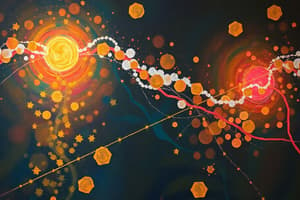Podcast
Questions and Answers
What type of bacteria are primarily involved in the sulfur cycle?
What type of bacteria are primarily involved in the sulfur cycle?
- Facultative anaerobes
- Non-sulfur photosynthetic bacteria
- Chemosynthetic bacteria
- Green and purple sulfur bacteria (correct)
Which process does anaerobic respiration NOT involve?
Which process does anaerobic respiration NOT involve?
- Use of organic compounds as electron acceptors
- Functioning in the absence of oxygen
- Reduction of inorganic compounds
- Use of gaseous oxygen as an electron acceptor (correct)
How much energy is typically lost at each transfer in a food chain?
How much energy is typically lost at each transfer in a food chain?
- 80 to 90% (correct)
- 50 to 60%
- 10 to 20%
- 100 to 110%
What characterizes a detritus food chain?
What characterizes a detritus food chain?
Which type of bacteria can function both with and without oxygen?
Which type of bacteria can function both with and without oxygen?
Which statement about food chains is true?
Which statement about food chains is true?
What role do chemotrophic bacteria play in their ecosystem?
What role do chemotrophic bacteria play in their ecosystem?
What defines a grazing food chain?
What defines a grazing food chain?
What is the main process that converts nitrogen into various chemical forms?
What is the main process that converts nitrogen into various chemical forms?
What percentage of Earth's atmosphere is comprised of nitrogen?
What percentage of Earth's atmosphere is comprised of nitrogen?
Which of the following processes is NOT part of the nitrogen cycle?
Which of the following processes is NOT part of the nitrogen cycle?
How do human activities impact the nitrogen cycle?
How do human activities impact the nitrogen cycle?
What form of nitrogen is primarily found in the atmosphere?
What form of nitrogen is primarily found in the atmosphere?
Which of the following best describes the role of bacteria in the nitrogen cycle?
Which of the following best describes the role of bacteria in the nitrogen cycle?
Which of the following forms of nitrogen is NOT a dissolved form?
Which of the following forms of nitrogen is NOT a dissolved form?
What effect does nitrogen scarcity have on ecosystems?
What effect does nitrogen scarcity have on ecosystems?
What does the equation ΔE = q + w represent?
What does the equation ΔE = q + w represent?
When does the internal energy of a system increase?
When does the internal energy of a system increase?
Which of the following best describes kinetic energy?
Which of the following best describes kinetic energy?
What does the second law of thermodynamics state about entropy?
What does the second law of thermodynamics state about entropy?
Which of the following processes results in negative values for q and w?
Which of the following processes results in negative values for q and w?
How is potential energy defined?
How is potential energy defined?
What happens to energy when water is raised against gravity?
What happens to energy when water is raised against gravity?
What is a characteristic feature of isolated systems, according to the second law of thermodynamics?
What is a characteristic feature of isolated systems, according to the second law of thermodynamics?
What is the primary process by which plants produce oxygen?
What is the primary process by which plants produce oxygen?
Which rock type is primarily formed from the cooling and solidification of magma?
Which rock type is primarily formed from the cooling and solidification of magma?
What role does the lithosphere play in the oxygen cycle?
What role does the lithosphere play in the oxygen cycle?
How does respiration by animals affect the carbon cycle?
How does respiration by animals affect the carbon cycle?
Which process primarily drives the changes in the rock cycle?
Which process primarily drives the changes in the rock cycle?
What percentage of the hydrosphere is oxygen by volume?
What percentage of the hydrosphere is oxygen by volume?
Which of the following is a primary agent affecting the sedimentary cycle?
Which of the following is a primary agent affecting the sedimentary cycle?
What happens to igneous rocks during the rock cycle?
What happens to igneous rocks during the rock cycle?
What do the prefixes ‘steno-‘ and ‘eury-‘ refer to in ecological terms?
What do the prefixes ‘steno-‘ and ‘eury-‘ refer to in ecological terms?
What is the optimum zone in the context of Shelford’s Law of Tolerance?
What is the optimum zone in the context of Shelford’s Law of Tolerance?
Which of the following terms describes a habitat that has a wide range of conditions that an organism can tolerate?
Which of the following terms describes a habitat that has a wide range of conditions that an organism can tolerate?
What is the role of salinity in aquatic ecosystems according to Shelford’s Law of Tolerance?
What is the role of salinity in aquatic ecosystems according to Shelford’s Law of Tolerance?
Which of the following best describes the critical minimum zone?
Which of the following best describes the critical minimum zone?
In terms of temperature tolerance, which of the following species would be classified using the term ‘stenothermal’?
In terms of temperature tolerance, which of the following species would be classified using the term ‘stenothermal’?
How is the concept of tolerance important in determining species abundance and distribution in ecosystems?
How is the concept of tolerance important in determining species abundance and distribution in ecosystems?
What does the 'euryhaline' term refer to concerning organisms in aquatic ecosystems?
What does the 'euryhaline' term refer to concerning organisms in aquatic ecosystems?
Flashcards are hidden until you start studying
Study Notes
Thermodynamics
- The first law of thermodynamics states: ΔE = q + w, where ΔE is the change in internal energy, q is heat flow, and w is work done on the system.
- Heat (q) and work (w) are processes that change a system's internal energy. Positive values indicate energy added to the system; negative values indicate energy leaving.
- Heat energy is molecular vibration and motion. Sunlight absorbed by land and water creates temperature differences, driving airflow (kinetic energy) which can perform work (e.g., pumping water). This work converts kinetic energy into potential energy (stored energy).
- Kinetic energy is energy of motion; potential energy is stored energy.
Entropy and the Second Law of Thermodynamics
- The second law of thermodynamics states that the entropy of an isolated system always increases. Isolated systems tend towards thermal equilibrium (maximum entropy). The universe’s entropy only increases.
Photosynthetic Bacteria
- Largely aquatic (marine and freshwater).
- Play a minor role in organic matter production; important in mineral cycling.
- Green and purple sulfur bacteria are obligate anaerobes (require no oxygen) and significant in the sulfur cycle.
- Non-sulfur photosynthetic bacteria are facultative anaerobes (can function with or without oxygen) and can be heterotrophs (obtain energy from other sources) in the absence of light.
Chemosynthetic Bacteria
- Considered "producers".
- Intermediate between autotrophic (make their own food) and heterotrophic (depend on others) organisms.
- Produce food via chemical oxidation of inorganic compounds (e.g., ammonia to nitrite, nitrite to nitrate, sulfide to nitrate, ferrous to ferric iron).
Respiration Types
- Aerobic respiration: uses oxygen as the final electron acceptor.
- Anaerobic respiration: uses an inorganic compound (other than oxygen) to accept electrons.
- Fermentation: an anaerobic process using an organic compound as the final electron acceptor.
Food Chains and Webs
- Food chain: transfer of energy from plants through a series of organisms (80-90% energy lost at each transfer).
- Grazing food chain: starts with plants, progresses to herbivores and then carnivores (can be predator or parasitic chains).
- Detritus food chain: starts with dead organic matter, decomposers, and then detritus feeders and their predators.
- Food webs are interconnected food chains.
The Nitrogen Cycle
- The conversion of nitrogen between its chemical forms through biological and physical processes.
- Key processes: fixation, ammonification, nitrification, and denitrification.
- Atmospheric nitrogen (78%) is largely unavailable for biological use.
- Human activities have significantly altered the global nitrogen cycle (fossil fuels, fertilizers, wastewater).
- Nitrogen exists in dissolved (organic and inorganic) and particulate forms in aquatic systems.
The Oxygen Cycle
- The oxygen cycle is interconnected with the carbon and hydrogen cycles.
- Primarily driven by photosynthesis (plants releasing oxygen) and respiration (animals consuming oxygen).
- The lithosphere (Earth's crust) stores oxygen in biomass, organic matter, and mineral deposits. Weathering releases trapped oxygen.
- The hydrosphere (water bodies) contains dissolved oxygen supporting aquatic life.
The Rock Cycle
- Describes the dynamic transitions between sedimentary, metamorphic, and igneous rocks.
- Driven by plate tectonics and the water cycle.
- Rocks change as they encounter different environments.
- Most elements and compounds follow a basic sedimentary cycle pattern involving erosion, sedimentation, mountain building, volcanic activity, and biological transport.
Shelford's Law of Tolerance
- An organism's presence and success depend on a complex of conditions.
- Absence or failure can be due to deficiency or excess of any single factor beyond tolerance limits.
- Species existence, abundance, and distribution are determined by whether physical/chemical factors fall within their tolerance range.
- Terms like "steno-" (narrow) and "eury-" (wide) describe tolerance levels (e.g., stenothermal vs. eurythermal for temperature).
- The zone of tolerance includes an optimum zone (best growth), a critical minimum zone (growth inhibited), and a critical maximum zone (growth ceases).
Salinity in Aquatic Ecosystems
- Salinity is a major factor in the distribution of marine, estuarine (brackish water), and freshwater species. It fundamentally shapes aquatic ecosystem structure and function.
Studying That Suits You
Use AI to generate personalized quizzes and flashcards to suit your learning preferences.




